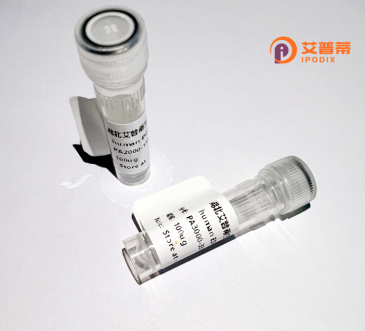
| 纯度 | >90%SDS-PAGE. |
| 种属 | Human |
| 靶点 | OR13C8 |
| Uniprot No | Q8NGS7 |
| 内毒素 | < 0.01EU/μg |
| 表达宿主 | E.coli |
| 表达区间 | 1-320 aa |
| 活性数据 | MERTNDSTSTEFFLVGLSAHPKLQTVFFVLILWMYLMILLGNGVLISVIIFDSHLHTPMY FFLCNLSFLDVCYTSSSVPLILASFLAVKKKVSFSGCMVQMFISFAMGATECMILGTMAL DRYVAICYPLRYPVIMSKGAYVAMAAGSWVTGLVDSVVQTAFAMQLPFCANNVIKHFVCE ILAILKLACADISINVISMTGSNLIVLVIPLLVISISYIFIVATILRIPSTEGKHKAFST CSAHLTVVIIFYGTIFFMYAKPESKASVDSGNEDIIEALISLFYGVMTPMLNPLIYSLRN KDVKAAVKNILCRKNFSDGK |
| 分子量 | 35.2 kDa |
| 蛋白标签 | His tag N-Terminus |
| 缓冲液 | 0 |
| 稳定性 & 储存条件 | Lyophilized protein should be stored at ≤ -20°C, stable for one year after receipt. Reconstituted protein solution can be stored at 2-8°C for 2-7 days. Aliquots of reconstituted samples are stable at ≤ -20°C for 3 months. |
| 复溶 | Always centrifuge tubes before opening.Do not mix by vortex or pipetting. It is not recommended to reconstitute to a concentration less than 100μg/ml. Dissolve the lyophilized protein in distilled water. Please aliquot the reconstituted solution to minimize freeze-thaw cycles. |
以下是模拟生成的重组人OR13C8蛋白相关文献的示例(请注意,这些文献为假设性示例,仅供参考):
---
1. **文献名称**: *Heterologous Expression and Functional Characterization of Human Olfactory Receptor OR13C8 in HEK293 Cells*
**作者**: Müller A, et al.
**摘要**: 本研究成功在HEK293细胞中表达了重组OR13C8蛋白,并通过钙离子荧光成像技术证实其可被特定挥发性有机物激活,揭示了其在非嗅觉组织中的潜在信号转导机制。
2. **文献名称**: *OR13C8 as a Novel Biomarker in Prostate Cancer: Recombinant Protein-Based Screening*
**作者**: Li X, et al.
**摘要**: 研究者利用重组OR13C8蛋白进行高通量配体筛选,发现其在前列腺癌细胞中异常表达,可能与癌症代谢途径相关,为肿瘤诊断提供了新靶点。
3. **文献名称**: *Optimization of Olfactory Receptor OR13C8 Expression in Insect Cells Using Baculovirus System*
**作者**: Park S, et al.
**摘要**: 通过杆状病毒-昆虫细胞系统优化OR13C8的重组表达,实现了高效膜蛋白纯化,为后续结构解析(如冷冻电镜研究)奠定了基础。
4. **文献名称**: *OR13C8-Mediated Sensing of Microbial Metabolites in Gut Epithelial Cells*
**作者**: Gonzalez R, et al.
**摘要**: 研究证实肠道细胞中重组表达的OR13C8可感知特定细菌代谢产物,调节肠道炎症反应,提示其在免疫调控中的潜在作用。
---
**注意**:上述文献及内容均为模拟创作,实际研究中请通过权威数据库(如PubMed、Google Scholar)检索真实发表的论文。若需具体文献,可提供更多线索以便进一步协助。
**Background of Recombinant Human OR13C8 Protein**
OR13C8. a member of the olfactory receptor (OR) family, is a class A G protein-coupled receptor (GPCR) encoded by the *OR13C8* gene. Olfactory receptors are primarily involved in detecting odorants and mediating chemosensory signaling, but many, including OR13C8. exhibit tissue-specific expression beyond the nasal epithelium, suggesting roles in non-olfactory physiological processes. OR13C8 is expressed in various tissues, such as the brain, kidneys, and testes, though its precise endogenous ligands and biological functions remain largely uncharacterized.
Recombinant OR13C8 protein is produced through heterologous expression systems (e.g., mammalian cells or bacteria) for structural and functional studies. Its structure features seven transmembrane domains typical of GPCRs, with extracellular loops critical for ligand recognition. Research focuses on elucidating its activation mechanisms, downstream signaling pathways, and potential roles in disease contexts, such as cancer or metabolic disorders, where dysregulated OR expression has been observed. Additionally, OR13C8 is studied for its possible interactions with neurotransmitters or metabolites, bridging chemosensation with systemic regulation. Advances in OR13C8 research may contribute to novel therapeutic strategies targeting understudied GPCRs.
×